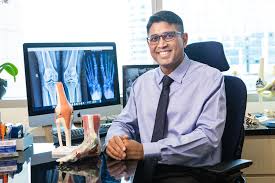1. Introduction
The healthcare system in Singapore is recognized around the world for its establishment as an international medical hub. For an island with a population of only 4 million, this is no easy feat. A third world country until the 1980s, the government has done well to be able to provide citizens with a world-class healthcare system. With only 1 doctor to every 1000 residents, the competition is fierce, with many clinicians fighting to get into both public and private institutions. With an aging population and increasing affluence, Singapore has been seeing a trend of increasing numbers of patients seeking more specialized care rather than settling for the convenience of a polyclinic.
2. Understanding Orthopaedic Care in Singapore
The discipline of orthopaedic surgery holds a significant place in many developed healthcare systems, but its role in Singapore is still relatively unknown. Orthopaedic surgery arose post-World War II and since then it has continued to advance in Singapore. There are currently four restructured hospitals offering residency training in orthopaedic surgery: Singhealth, National Healthcare Group (NHG), Changi General Hospital, and KK Women’s and Children’s Hospital. Residents in MOH hospitals undergo rotations in General Surgery, Accident & Emergency, Orthopaedic Surgery, and other related postings such as Rheumatology and Rehabilitation Medicine. In addition to the rotations, there are weekly protected teaching sessions comprising of didactic lectures, journal club, and case presentations. Residents are also involved in scientific research at the separate campuses of the Singhealth and NHG research institutes. National University of Singapore (NUS) has a department of Orthopaedic Surgery which has nurtured many of the orthopaedic surgeons currently practicing in Singapore. The department has been integral to the development of the NUS medical school curriculum and offers formal teaching to medical students in the form of lectures, tutorials, and clinical attachments. An orthopaedic clinic Singapore can help you regain your mobility and way of life.
3. Choosing the Right Bone Specialist
At The Orthopaedic and Pain Practice in Singapore, patients experiencing orthopedic concerns find compassionate and comprehensive care tailored to their individual needs. With a team of skilled orthopedic specialists and pain management experts, the practice offers a holistic approach to diagnosis, treatment, and rehabilitation. From innovative surgical interventions to non-invasive therapies, such as physiotherapy and pain management techniques, patients receive personalized treatment plans aimed at restoring function, reducing pain, and improving overall quality of life. With a focus on patient education and empowerment, The Orthopaedic and Pain Practice strives to guide individuals through every step of their orthopedic journey, fostering trust, confidence, and optimal recovery outcomes.
Ask your bone specialist how many of these operations they perform per year and what their results are. Find out if they have any special expertise in the particular condition that you have. Do some research. Find out how many of these operations the specialist you are considering has performed. A recent review of Medicare data in the US revealed that most surgeons who perform a specific operation do so infrequently. In 2008, 66% of shoulder surgeons performed fewer than 6 subacromial decompressions, which is a very common shoulder operation. It is a commonly held belief in healthcare that higher surgeon volume is correlated with better patient outcomes.
Some orthopedic specialists focus on a wide range of orthopedic conditions; others may specialize in a specific area within orthopedics, such as the neck, spine, hip, knee, or foot. When it comes to managing specific orthopedic conditions, there is no substitute for experience. A specialist who regularly manages patients with that condition will have a greater depth of understanding of the best management options and will often achieve better results. The industry for orthopaedic Singapore is regarded as a trustworthy.
4. Conclusion
Throughout all these years, the team at TOPP have seen and treated numerous cases concerning the musculoskeletal system, and the goal has always been to help manage and improve the quality of life for everyone. With this guide, it helps to bridge the gap between what doctors in the clinic want to know and what patients need to know before seeing a specialist. Moving forward, the team at The Orthopaedic and Pain Practice are ready to answer your questions about these conditions. These can range from conventional, non-operative management to surgical options, as well as tailored rehabilitation guidelines for patients. We also hope to engage the community to generate more discussion in the public, to create better awareness for musculoskeletal conditions. In time to come, we hope to see a decrease in the number of patients suffering from chronic musculoskeletal conditions and improve their quality of life with the resources made available to them





